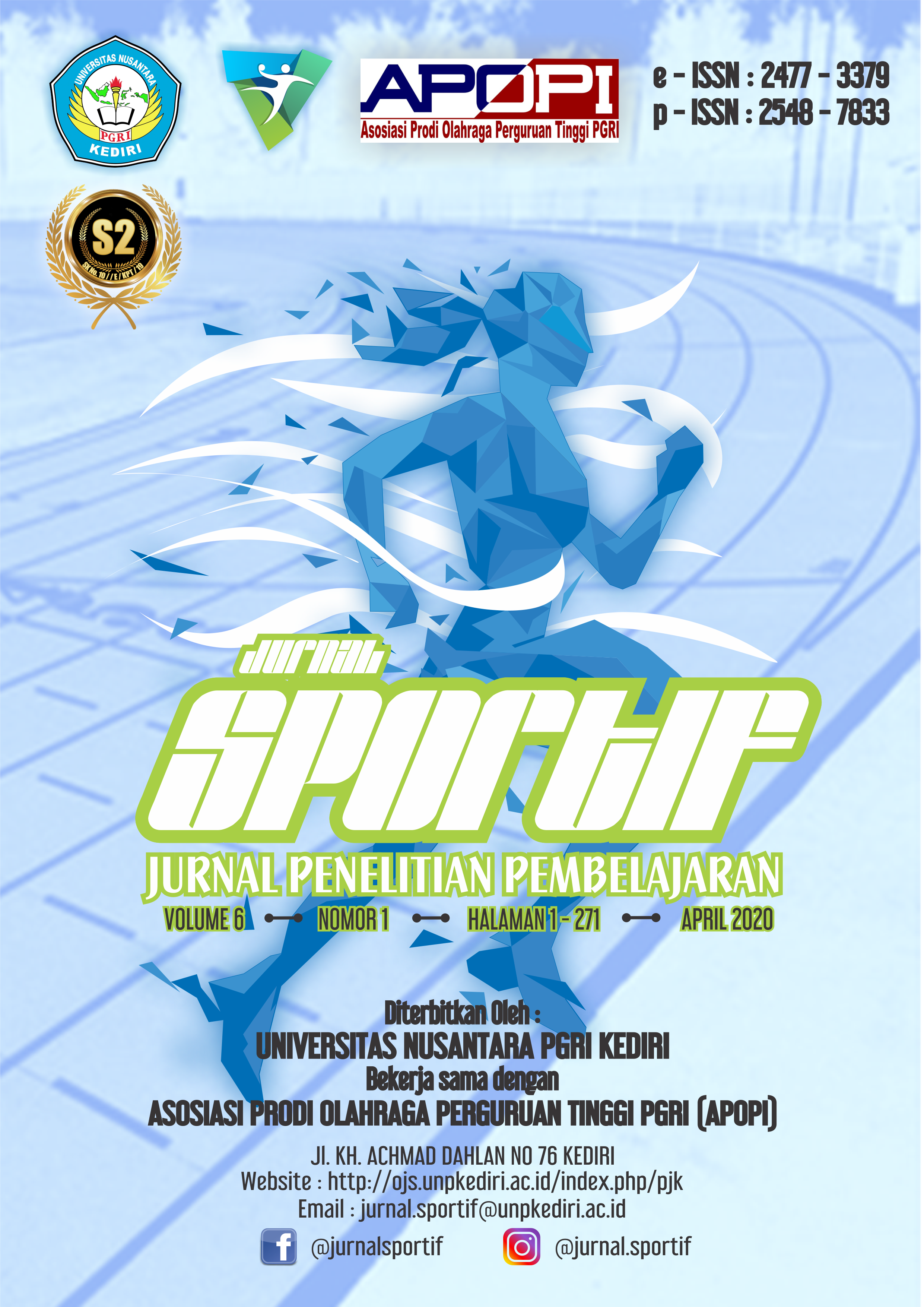Abstrak
This study aims to produce a model of introduction to the basis of sepak takraw basic techniques through a play approach for elementary school children of upper class. This research was carried out by adapting the 8 steps of the Borg & Gall research, these steps include: (1) gathering field information, (2) analyzing the information that has been collected, (3) developing initial products, (4) expert validation and revisions, (5) small-scale field trials and revisions, (6) large-scale field trials and revisions, (7) manufacturing of final products, (8) product effectiveness tests. A small-scale trial was carried out on 22 upper-grade elementary school children (SDN Sukorejo 01). A large-scale trial was conducted on 82 high school elementary school children (SDN Bendogerit 02, SDN Gedog 02, and SDN Sentul 01). The instruments used for data collection were observation guidelines, interviews, field notes, value scales, effectiveness test assessment sheets, and assessment of learning outcomes. The results of this study are in the form of an introduction to the basic techniques of sepak takraw through a play approach, which contains 5 game models based on the sepak takraw basic techniques and arranged in the form of a game manual. From the results of the assessment of material experts and practitioners, it can be concluded that the introduction of the sepak takraw basic techniques through the play approach for elementary school children is categorized as good and effective, so that the game model is feasible to use.
Referensi
Ardiyanto, A., & Sukoco, P. (2014). Pengembangan Model Pembelajaran Berbasis Permainan Tradisional untuk Meningkatkan Kemampuan Motorik Kasar Anak Tunagrahita Ringan. Jurnal Keolahragaan. https://doi.org/10.21831/jk.v2i2.2608
Ayre, C., & Scally, A. J. (2014). Critical values for Lawshe’s content validity ratio: Revisiting the original methods of calculation. Measurement and Evaluation in Counseling and Development. https://doi.org/10.1177/0748175613513808.
Azwar, S. (2012). Penyusunan Skala Psikologi. Yogyakarta: Pustaka Pelajar.
Chueachot, S., Srisa-Ard, B., & Srihamongkol, Y. (2013). The development of an assessment for learning model for elementary classroom. International Education Studies. https://doi.org/10.5539/ies.v6n9p119.
Datta, P. P. A. K., & Purashwani, M. (2010). Construction of Norms for Skill Test Table Tennis Players. International Journal of Table Tennis Sciences.
Gall, M. D., Gall, J. P., & Borg, W. R. (2006). Educational Research: An Introduction, 8th Edition. Educational An Introduction.
John Wiley and Sons. (2012). Coaching sience (Theory into practice). England: British library.
Juniarta, T., & Siswantoyo, S. (2014). Pengembangan Model Permainan Rintangan (Handicap Games) untuk Latihan Kebugaran Jasmani Anak Usia 10-12 Tahun. Jurnal Keolahragaan. https://doi.org/10.21831/jk.v2i1.2606.
Kurdi, K., & Sukadiyanto, S. (2014). Pengembangan Model Pembelajaran Motorik dengan Pendekatan Bermain Menggunakan Agility Ladder untuk Anak Sekolah Dasar. Jurnal Keolahragaan. https://doi.org/10.21831/jk.v2i2.2625.
Lumintuarso, R. (2013). Pembinaan multilateral bagi atlet pemula (pedoman latihan dasar bagi atlet muda berbakat). Yogyakarta: UNY Press.
Meltzer, D. E. (2002). The relationship between mathematics preparation and conceptual learning gains in physics: A possible “hidden variable” in diagnostic pretest scores. American Journal of Physics. https://doi.org/10.1119/1.1514215.
Mohnsen, B. S. (2008). Teaching middle school physical education. United States: Human Kinetics.
Ngatiyo. (2008). Membelajarkan anak usia dini melalui bermain. Jurnal Cakrawala Kependidikan Pontianak: Universitas Tanjungpura., 6(2).
Payne, V. G., & Isaacs, L. D. (2011). Human Motor Development: A LifeSpan Approach. In Human Motor Development: https://doi.org/10.4324/9781315213040.
Scharf, M., & Mayseless, O. (2009). Socioemotional characteristics of elementary school children identified as exhibiting social leadership qualities. Journal of Genetic Psychology. https://doi.org/10.3200/GNTP.170.1.73-96.
Simamora, R. H. (2009). Buku ajar pendidikan dalam keperawatan (K. EGC, ed.). Jakarta: (IKAPI).
Sugiyono, P. D. metode penelitian kuantitatif, kualitatif,dan R&D. , Alfabeta, cv. (2016).
Suharti, S., & Darisman, E. K. (2017). Pengaruh Senam Semangat Pagi (SSP) Terhadap Peningkatan Kebugaran Siswa Kelas XI SMAN 4 Sidoarjo. Jurnal SPORTIF: Jurnal penelitian Pembelajaran. https://doi.org/10.29407/js_unpgri.v3i2.11894.
Sukmadinata, N. S. (2012). Kurikulum dan Pembelajaran Kompetensi. Bandung: PT Refika Aditama.
Sun, H. (2013). Impact of exergames on physical activity and motivation in elementary school students: A follow-up study. Journal of Sport and Health Science. https://doi.org/10.1016/j.jshs.2013.02.003.
Utami, N. S., & Sukadiyanto, S. (2014). Model Pengenalan Air Bagi Siswa Taman Kanak-Kanak. Jurnal Keolahragaan. https://doi.org/10.21831/jk.v2i2.2626.
Zetou, E., Papadakis, L., Vernadakis, N., Derri, V., Bebetsos, E., & Filippou, F. (2014). The Effect of Variable and Stable Practice on Performance and Learning the Header Skill of Young Athletes in Soccer. Procedia - Social and Behavioral Sciences. https://doi.org/10.1016/j.sbspro.2014.09.328
##submission.copyrightStatement##

